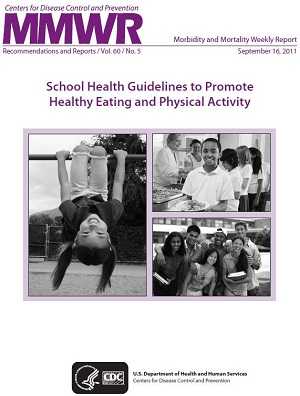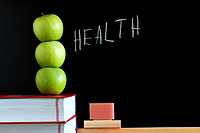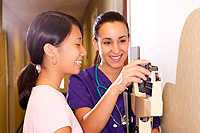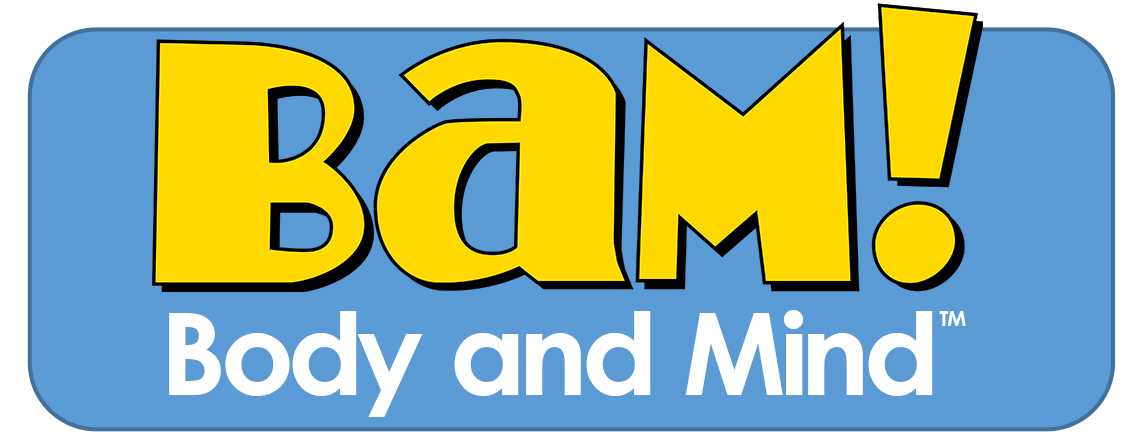School Health Guidelines
Schools play a critical role in improving the dietary and physical activity behaviors of children and adolescents. Schools can create environments that are supportive of healthy eating and physical activity by implementing policies and practices. Providing students with learning opportunities that support healthy eating and regular physical activity is also important for students to learn about and practice these behaviors.
CDC synthesized research and best practices related to promoting healthy eating and physical activity in schools, culminating in nine guidelines. These guidelines were informed by the Dietary Guidelines for Americans,1 the Physical Activity Guidelines for Americans,2 and the Healthy People 2020 objectives related to healthy eating and physical activity among children, adolescents, and schools.3 The guidelines serve as the foundation for developing, implementing, and evaluating school-based healthy eating and physical activity policies and practices for students.

Executive Summary [PDF – 5.09 MB]
Complete Guidelines [PDF – 973.44 KB]
Tips for Teachers [PDF – 548 KB]
- Guideline 1
- Guideline 2
- Guideline 3
- Guideline 4
- Guideline 5
- Guideline 6
- Guideline 7
- Guideline 8
- Guideline 9
- Conclusion
Use a Coordinated Approach to Develop, Implement, and Evaluate Healthy Eating and Physical Activity Policies and Practices
 Representatives from different segments of the school and community, including parents and students, should work together to maximize healthy eating and physical activity opportunities for students.
Representatives from different segments of the school and community, including parents and students, should work together to maximize healthy eating and physical activity opportunities for students.
Strategies
- Coordinate healthy eating and physical activity policies and practices through a school health council and school health coordinator
- Assess healthy eating and physical activity policies and practices
- Use a systematic approach to develop, implement, and monitor healthy eating and physical activity policies
- Evaluate healthy eating and physical activity policies and practices
Resources
Establish School Environments that Support Healthy Eating and Physical Activity
 The school environment should encourage all students to make healthy eating choices and be physically active throughout the school day.
The school environment should encourage all students to make healthy eating choices and be physically active throughout the school day.
Strategies
- Provide access to healthy foods and physical activity opportunities and to safe spaces, facilities, and equipment for healthy eating and physical activity.
- Establish a climate that encourages and does not stigmatize healthy eating and physical activity.
- Create a school environment that encourages a healthy body image, shape, and size among all students and staff members, is accepting of diverse abilities, and does not tolerate weight-based teasing.
Resources
- USDA School Food Safety Resources
- USDA School Garden Fact Sheet [PDF-160KB]
- CDC’s Increasing Access to Drinking Water in Schools Toolkit [PDF-1.47MB]
- U.S. Consumer Product Safety Commission Resources
- ChangeLab Solutions Joint Use Agreement Resources
- Action for Healthy Kids Non-Food Reward Ideas [PDF-793KB]
Provide a Quality School Meal Program and Ensure that Students Have Only Appealing, Healthy Food and Beverage Choices Offered Outside of the School Meal Program
 Schools should model and reinforce healthy dietary behaviors by ensuring that only nutritious and appealing foods and beverages are provided in all food venues in schools, including school meal programs; à la carte service in the cafeteria; vending machines; school stores and snack bars/concessions stands; fundraisers on school grounds; classroom-based activities; staff and parent meetings; and after-school programs.
Schools should model and reinforce healthy dietary behaviors by ensuring that only nutritious and appealing foods and beverages are provided in all food venues in schools, including school meal programs; à la carte service in the cafeteria; vending machines; school stores and snack bars/concessions stands; fundraisers on school grounds; classroom-based activities; staff and parent meetings; and after-school programs.
Strategies
- Promote access to and participation in school meals.
- Provide nutritious and appealing school meals that comply with the Dietary Guidelines for Americans.
- Ensure that all foods and beverages sold or served outside of school meal programs are nutritious and appealing.
Resources
- US Department of Agriculture’s Team Nutrition
- US Department of Agriculture’s School Meal Program
- CDC guidance and resources about school nutrition
- CDC’s Comprehensive Framework for Addressing the School Nutrition Environment and Services [PDF – 2.95MB]
- Alliance for a Healthier Generation School Meal Resources
- Alliance for a Healthier Generation School Snacks and Beverages Resources
- Action for Healthy Kids Healthy Fundraising Ideas [PDF-567KB]
- US Department of Agriculture Food Marketing and Advertising
Implement a Comprehensive Physical Activity Program with Quality Physical Education as the Cornerstone
 Children and adolescents should participate in 60 minutes of physical activity every day. A substantial percentage of students’ physical activity can be provided through a comprehensive, school-based physical activity program that includes these components: physical education, recess, classroom-based physical activity, walk and bicycle to school, and out-of-school time activities.
Children and adolescents should participate in 60 minutes of physical activity every day. A substantial percentage of students’ physical activity can be provided through a comprehensive, school-based physical activity program that includes these components: physical education, recess, classroom-based physical activity, walk and bicycle to school, and out-of-school time activities.
Strategies
- Require students in grades K–12 to participate in daily physical education that uses a planned and sequential curriculum and instructional practices that are consistent with national or state standards for physical education.
- Provide a substantial percentage of each student’s recommended daily amount of physical activity in physical education class.
- Use instructional strategies in physical education that enhance students’ behavioral skills, confidence in their abilities, and desire to adopt and maintain a physically active lifestyle.
- Provide ample opportunities for all students to engage in physical activity outside of physical education class.
- Ensure that physical education and other physical activity programs meet the needs and interests of all students.
Resources
- CDC’s Comprehensive School Physical Activity Program: A Guide for Schools [PDF-6.44MB]
- CDC’s Physical Education Curriculum Analysis Tool
- CDC’s Youth Physical Activity Guidelines Toolkit
- SHAPE America Comprehensive School Physical Activity Program website
- SHAPE America’s Essential Components of Physical Education [PDF-391KB]
- National Center for Safe Routes to School
Implement Health Education that Provides Students with the Knowledge, Attitudes, Skills, and Experiences Needed for Lifelong Healthy Eating and Physical Activity
 Health education is integral to the mission of schools, providing students with the knowledge and skills they need to become successful learners and healthy adults.
Health education is integral to the mission of schools, providing students with the knowledge and skills they need to become successful learners and healthy adults.
Strategies
- Require health education from pre-kindergarten through grade 12.
- Implement a planned and sequential health education curriculum that is culturally and developmentally appropriate, addresses a clear set of behavioral outcomes that promote healthy eating and physical activity, and is based on national standards.
- Use curricula that are consistent with scientific evidence of effectiveness in helping students improve healthy eating and physical activity behaviors.
- Use classroom instructional methods and strategies that are interactive, engage all students, and are relevant to their daily lives and experiences.
Resources
Provide Students with Health, Mental Health, and Social Services to Address Healthy Eating, Physical Activity, and Related Chronic Disease Prevention
 Schools are responsible for students’ physical health, mental health, and safety during the school day. Schools should ensure resources are available for identification, follow-up, and treatment of health and mental health conditions related to diet, physical activity, and weight status.
Schools are responsible for students’ physical health, mental health, and safety during the school day. Schools should ensure resources are available for identification, follow-up, and treatment of health and mental health conditions related to diet, physical activity, and weight status.
Strategies
- Assess student needs related to physical activity, nutrition, and obesity, and provide counseling and other services to meet those needs.
- Ensure students have access to needed health, mental health, and social services.
- Provide leadership in advocacy and coordination of effective school physical activity and nutrition policies and practices.
Resources
Partner with Families and Community Members in the Development and Implementation of Healthy Eating and Physical Activity Policies, Practices, and Programs
 Partnerships among schools, families, and community members can enhance student learning, promote consistent messaging about health behaviors, increase resources, and engage, guide, and motivate students to eat healthily and be active.
Partnerships among schools, families, and community members can enhance student learning, promote consistent messaging about health behaviors, increase resources, and engage, guide, and motivate students to eat healthily and be active.
Strategies
- Encourage communication among schools, families, and community members to promote adoption of healthy eating and physical activity behaviors among students.
- Involve families and community members on the school health council.
- Develop and implement strategies for motivating families to participate in school-based programs and activities that promote healthy eating and physical activity.
- Access community resources to help provide healthy eating and physical activity opportunities for students.
- Demonstrate cultural awareness in healthy eating and physical activity practices throughout the school.
Resources
Provide a School Employee Wellness Program that Includes Healthy Eating and Physical Activity Services for all School Staff Members
 School employee wellness programs can improve staff productivity, decrease employee absenteeism, and decrease employee health care costs.
School employee wellness programs can improve staff productivity, decrease employee absenteeism, and decrease employee health care costs.
Strategies
- Gather data and information to determine the nutrition and physical activity needs of school staff members and assess the availability of existing school employee wellness activities and resources.
- Encourage administrative support for and staff involvement in school employee wellness.
- Develop, implement, and evaluate healthy eating and physical activity programs for all school employees.
Resources
Employ Qualified Persons, and Provide Professional Development Opportunities for Physical Education, Health Education, Nutrition Services, and Health, Mental Health, and Social Services Staff Members, as well as Staff Members Who Supervise Recess, Cafeteria Time, and Out-of-School-Time Programs
 Providing certified and qualified staff with regular professional development opportunities enables them to improve current skills and acquire new ones.
Providing certified and qualified staff with regular professional development opportunities enables them to improve current skills and acquire new ones.
Strategies
- Require the hiring of physical education teachers, health education teachers, and nutrition services staff members who are certified and appropriately prepared to deliver quality instruction, programs, and practices
- Provide school staff with annual professional development opportunities to deliver quality physical education, health education, and nutrition services
- Provide annual professional development opportunities for school health, mental health, and social services staff members, and staff members who lead or supervise out-of-school time programs, recess, and cafeteria time
Resources
Implementing and sustaining school-based healthy eating and physical activity policies and programs will make a powerful contribution toward a healthy future for students in the United States. By adopting these nine guidelines, schools can help ensure that all students have the opportunity to attain their maximum educational potential and pursue a lifetime of good health.
SHG e-Learning Course
The purpose of this module is to provide you with in-depth information on the School Health Guidelines to Promote Healthy Eating and Physical Activity. After this module, you will be ready to take initial steps to improve healthy eating and physical activity in your school or district.
The course objectives are for you to:
- Gain familiarity of the nine school health guidelines to promote healthy eating and physical activity.
- Identify and learn about strategies to create opportunities for students to participate in more physical activity and improve healthy eating.
Related Guidelines and Resources
Tips for Teachers [PDF – 548 KB]
Tips and resources for teachers to promote healthy eating and physical activity in the classroom
2015 Dietary Guidelines for Americans
Science-based recommendations to help persons aged 2 years or older implement good dietary habits that can promote health and reduce risk for major chronic diseases
2008 Physical Activity Guidelines for Americans
Science-based recommendations to help persons aged 6 years or older improve their health through physical activity
Healthy People 2020 Topics and Objectives
Science-based, 10-year objectives for improving the health of Americans
References
- US Department of Agriculture, US Department of Health and Human Services. Dietary Guidelines for Americans, 2010. 7th edition. Washington, DC: US Government Printing Office; 2010.
- US Department of Health and Human Services. 2008 Physical Activity Guidelines for Americans. Washington, DC: US Department of Health and Human Services; 2008.
- US Department of Health and Human Services, Office of Disease Prevention and Health Promotion. Healthy People 2020. Rockville, MD: 2010. Report No. B0132.
- Page last reviewed: September 5, 2017
- Page last updated: September 5, 2017
- Content source:



 ShareCompartir
ShareCompartir